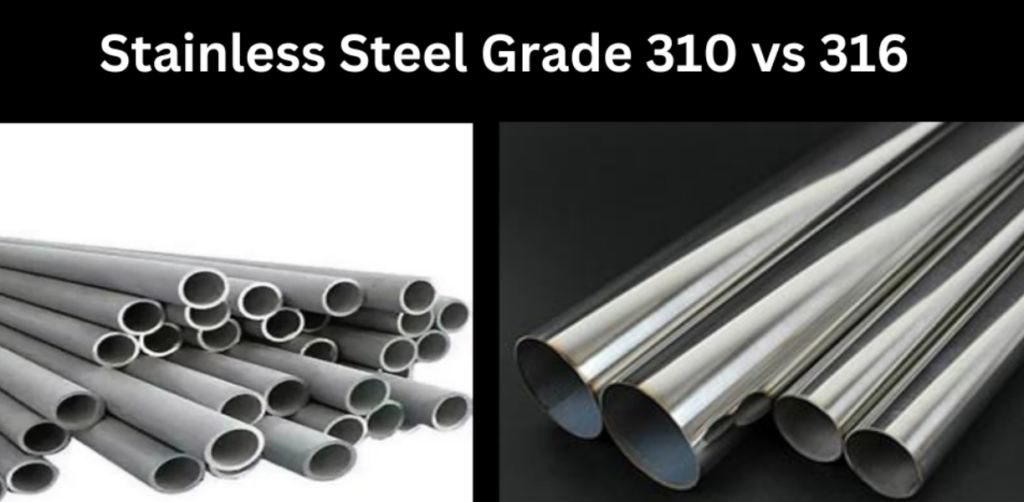In the world of metal materials, there are many types of stainless steel, each with its own unique properties and application areas. Among them, 316 tšepe e sa hloekang 'me 310s tšepe e sa hloekang have been widely used in various industrial fields due to their excellent properties. However, despite their belonging to the category of stainless steel, there are still some important differences between them. So, stainless steel 310s vs 316 – what is the difference? This article will explore in detail the properties of these two mefuta ea tšepe e sa hloekang and their differences in application.

Stainless Steel 310s vs 316 - Phapano ke Efe?
The difference between 310S and 316 stainless steel is that 310S has better high-temperature resistance, while 316 stainless steel has better corrosion resistance. 310S (0Cr25Ni20) is an austenitic chromium-nickel stainless steel with good oxidation resistance and corrosion resistance. Due to the higher percentage of chromium and nickel, 310S has better creep strength and can operate continuously at high temperatures, with good high-temperature resistance. While 316 stainless steel is a chromium-nickel stainless steel with good corrosion resistance, suitable for chemical, textile, paper, pharmaceutical, and other industries.
Ka mohlala, 310S can be applied to high-temperature components such as furnace pipes, furnace doors, furnace plates, and furnace racks. While 316 stainless steel can be applied to marine environments, chemical processing, pharmaceutical equipment, and other fields.
The manufacturing process and requirements for 310S stainless steel furnace doors and pipelines are relatively strict. For example, when manufacturing 310S stainless steel furnace doors, cold drawing or cold rolling processes are required to ensure the dimensional accuracy and surface quality of the product. When manufacturing 310S stainless steel pipelines, seamless or welded pipes are required, and strict nondestructive testing is performed.
Stainless Steel 310s vs 316 – Production Process:
Specifically, the process flow for making a 310S stainless steel furnace door is as follows: ① selecting the appropriate 310S stainless steel plate; ② cutting, bending, forming, and other processing of the plate; ③ performing cold drawing or cold rolling processes; ④ performing surface treatment, such as polishing, sandblasting, etc.; ⑤ performing testing and packaging1.
The process flow for manufacturing 310S stainless steel pipes is as follows: ① selecting suitable 310S stainless steel pipe materials; ② cutting, forming, and other processing of the pipe materials; ③ performing seamless or welding processes; and ④ performing nondestructive testing.
Ho phaella moo, khopolo ea austenitic tšepe e sa hloekang refers to stainless steel with austenite structure at room temperature. When the steel contains about 18% Cr, 8% to 25% Ni, and about 0.1% C, it has a stable austenite structure. Austenitic chromium-nickel stainless steel includes the well-known 18Cr-8Ni steel and the high Cr-Ni series of steel developed by adding Cr, Ni, Mo, Cu, Si, Nb, Ti, and other elements to it. Austenitic stainless steel is non-magnetic and has no cold brittleness. The face-centered cubic crystals have higher density than the body-centered cubic crystals, so austenitic stainless steel has high corrosion resistance and good weldability.
fihlela qeto e
Thank you for reading our article and we hope it can help you to have a better understanding of the differences between stainless steel 310s vs 316. If you want to find more information about stainless steel 310s and 316, we would advise you to visit Sino Stainless Steel.
As a leading supplier of stainless steel products from China, Sino Stainless Steel provides our customers with likhoele tsa tšepe tse sa hloekang, lipoleiti tsa tšepe tse sa hloekang, carbon steel, mekoallo ea tšepe e sa hloekang, 'me li-tubes tsa tšepe tse sa hloekang ka theko e phahameng haholo.
 : + 86-18621535697
: + 86-18621535697  :export81@huaxia-intl.com
:export81@huaxia-intl.com